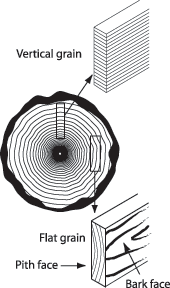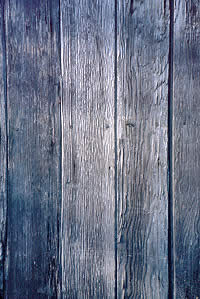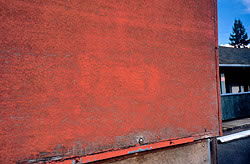
Preventing Coating Failures on Wood
Even the best coatings will sometimes fail on improperly prepared wood. Learn what you can do to ensure a long-lasting paint job.
by Gail Elber
as well as a painter, you don’t have much control over the selection and installation of the wood you paint. Nevertheless, understanding how wood and paint interact will help you create finishes with lasting good looks. And if you’re called in to diagnose a peeling mess, this understanding can help you identify a coating failure caused by something only a builder can correct.
To understand why wood and paint sometimes don’t get along, you must understand wood’s anatomy, shown in figure 1. A piece of lumber contains various components that react differently to environmental conditions. Springwood, or earlywood, produced when the tree is growing rapidly early in the year, is light-colored and porous. Summerwood, or latewood, produced later in the year when the tree is growing more slowly, is darker and denser.
Wood swells when it absorbs water or water vapor and shrinks when it dries out. The extent of swelling and shrinking depends on the humidity, the species, and what part of the log the board came from. If a paint film isn’t thick and elastic enough to expand and contract with the wood, it will crack.
When it contains about 12 percent water by weight, wood is at its average size. If you test the wood with a moisture meter and paint the wood at this point, you’ll minimize the amount of shrinking and stretching the paint film will have to do. To minimize swelling and shrinking, the passage of liquid water and water vapor into and out of the wood must be minimized. Some water-fighting measures are up to the builder; buildings must have adequate eaves to keep off the rain, and proper vapor barriers must be installed to keep moist interior air from penetrating to the siding. Other measures are up to the building’s owner, who must clean the gutters and repair leaks. But the painter does play a part in protecting wood from water.
When you apply a film-forming finish such as paint or opaque stain, wood absorbs only an insignificant amount of the vehicle, whether it’s water or oil. The purpose of sanding or cleaning wood before painting is not to promote absorption, but rather to remove dirt, microorganisms, or degraded wood, to which the paint film can’t adhere.
To prevent premature paint failure and deterioration of siding, treat new exterior wood with a water repellent before painting. Water repellents contain wax that repels liquid water but allows water vapor to pass into and out of the wood.  In contrast to paints, penetrating finishes such as transparent stains are absorbed into the cell walls of the wood, so before staining, you must remove any barriers to this absorption, such as mill glaze or old waterproofing. Typically, stains contain a water-repellent compound, transparent pigments, and sometimes oils that sink into the wood. Opaque stains have similar components, which are similarly absorbed, and also contain opaque pigments that remain in a thin film on the wood’s surface. In contrast to paints, penetrating finishes such as transparent stains are absorbed into the cell walls of the wood, so before staining, you must remove any barriers to this absorption, such as mill glaze or old waterproofing. Typically, stains contain a water-repellent compound, transparent pigments, and sometimes oils that sink into the wood. Opaque stains have similar components, which are similarly absorbed, and also contain opaque pigments that remain in a thin film on the wood’s surface. Neither paint nor stain prevents wood from absorbing moisture, though a paint film slows down the passage of water vapor. In fact, paint can actually accelerate the decay of wood; once the finish cracks and admits liquid water, the paint slows down the exit of moisture from the wood, fostering the growth of decay fungi. A perfectly applied coat of paint on perfectly waterproofed siding would develop a chalky surface over time, but the underlying layer would stick tightly to the wood for ten years until it was so faded that repainting was necessary. The perfect coat of opaque stain would behave similarly. In contrast, perfectly applied transparent stain would gradually weather away for a few years until the sun could get through and turn the underlying wood gray. However, in the real world, exterior paints and stains generally fail by peeling off or getting blotchy. These failures usually can be traced to the action of moisture on wood. The accompanying table summarizes the paint-friendliness of common siding species for oil and latex paints.

Here are some of the ways that wood’s properties can make paint fail, and some ways to prevent these problems.
Raised grain: When wood is planed at the mill with dull blades, the dense latewood bands are forced into the surface, crushing the porous earlywood below them. When the wood absorbs moisture, the underlying earlywood swells, pushing up the latewood into ridges. If the paint can’t stretch enough to cover the ridges, a characteristic pattern of cracks following the grain lines results (figure 2). This cracking often occurs when a single coat of opaque stain is applied to the pith side of flat-grained lumber — the pigment film isn’t as thick and elastic as a paint film is. Prevention: Hose down newly installed siding with water to let the crushed wood swell, and then let it dry before applying waterproofing. After that, it takes one coat of primer and two topcoats to create the 4- to 5-mil film needed to withstand siding’s normal dimensional changes.
Weathering before painting: If smooth-planed wood has been exposed to sunlight for more than two weeks, ultraviolet (UV) degradation will impair the adhesion of paint to the surface, and the paint will peel prematurely.
Prevention: Scuff-sand the surface with 50- to 80-grit sandpaper to remove the degraded layer. A thorough finish sanding is not needed. Just give the siding a once-over with a drywall sanding pad on a pole. Wood that has been stored indoors for several months should also be scuff-sanded before finishing.
Weathering before staining: Researchers have found that a few weeks of preweathering will increase the absorption of both water-based and oil-based stains into Western red cedar and redwood siding. But this increased absorption does not result in a longer service life for the finish. You’ll use up more stain, but the finish won’t last any longer. In fact, for a good appearance and maximum protection, uniform absorption, not deep absorption, is necessary. So don’t deliberately preweather new siding. Instead, as soon as possible after the siding or deck is up, pressure-wash the wood with the stain manufacturer’s recommended cleaner or “brightener.” These agents contain bleaches, acids, or alkalis, plus surfactants that remove dirt and the gray layer of UV-degraded wood. They’ll also remove traces of water-repellent agents remaining from previous coats of stain. After the wood has dried, apply the new stain.
Paint peeling on some siding boards and not others: As the humidity changes, the pith side of a board (see figure 1) shrinks and swells more than the bark side. If siding is resawn from dimensional lumber so that it has a designated “out” side, half the boards will expose their pith side, and half will expose their bark side. The boards installed pith-side-out will shrink and swell more, causing the paint film to fail there first (figure 2). Prevention: Minimizing the siding’s water absorption is largely up to the builder. Good construction practices will minimize both migration of water vapor from indoors and infiltration of rain and dew into the siding. Painting the backs and edges of siding boards or panels helps with this. For your part, make that exterior paint film as strong and flexible as possible with proper preparation and application.
Patchy failure on fingerjointed lumber: In the manufacture of fingerjointed trim and siding, pieces from different parts of the log are mixed, and each piece may shrink and swell to a different extent. Prevention: For the builder: Fingerjointed siding with a rough-sawn surface is less liable to patchy peeling than smooth fingerjointed siding. For you: Test moisture at several points in fingerjointed material to make sure all the pieces have approximately the same moisture content.
Extractive stains: The heartwood and knots of many wood species contain colored chemicals that can leach out and discolor paint. Some of these chemicals are water-soluble, including those found in redwood and western red cedar. Others are oily, such as the pitch found in pine heartwoods and knots.
Water-soluble extractives should stay in the wood harmlessly unless something is wrong. If extractive stains appear, water is passing through the wood. You and a builder will need to prowl around to ascertain whether the water is entering via faulty roof drainage or a failing paint job. Prevention: As with practically every other paint problem, keeping moisture out of the siding is the way to keep water-soluble extractives in their place.
Pitchy materials are supposed to harden and become inert during kiln-drying, but that doesn’t always happen. Prevention: Pitch should stay put if streaks or knots are covered, before priming, with a special knot sealer formulated for the purpose.
Blue stains come from fungi that flourish in cut logs that aren’t immediately taken to the mill. In dry wood, blue stain is structurally harmless and can be covered by primer, but spreading blue stain is an indication that the wood’s moisture content is exceeding 20 percent, and that is likely to lead to other problems.
Suitability of finishes for various softwoods. I is best, IV is worst.*
| |
Shrinkage from green to dry (%)** |
Paint-holding ability |
| Species |
Flat grain |
Vertical grain |
Oil-based |
Latex |
| Bald Cypress |
6.2 |
3.8 |
I |
I |
| Western Red Cedar |
5.0 |
2.4 |
I |
I |
| Douglas Fir |
7.6 |
4.8 |
IV |
II |
| Southern Pine |
8.0 |
5.0 |
IV |
III |
| Old-growth Redwood |
4.4 |
2.6 |
I |
I |
| Western Hemlock |
7.8 |
4.2 |
III |
II |
| *For information about other woods, consult the Forest Service Forest Products Laboratory's Handbook of Wood as an Engineering Material, section 15-3, available at http://www.fpl.fs.fed.us/pub_lists.htm. |
| **This gives a relative indication of how much the wood shrinks and swells in service. |
Though manufactured siding is made under more controlled conditions than trees are, these products are still subject to water-related paint failures.
Plywood and T1-11 siding are made from veneers peeled from a log on a lathe. The surface of plywood is sanded smooth, and T1-11 has a rough-sawn surface with open grooves that simulate the appearance of boards.
Plywood and T1-11 panels with resin-impregnated paper overlays are available. Medium-density overlay (MDO) has less resin than high-density overlay (HDO).
Plywood and T1-11 come from the mill with hairline cracks called face checks in the face veneers caused by the peeling process. After repeated shrinking and swelling, these checks can open wide enough to split a paint film, admitting moisture and causing peeling (figure 3). For this reason, MDO, and HDO are better choices than sanded plywood for exterior applications. Rough-sawn plywood and T1-11 also perform well, because their rough surface allows the paint film to flex more than it can on sanded plywood.
Paint peeling along the grain lines of plywood. In plywood, the grain lines appear as wide bands. On a sanded plywood surface, paint will sometimes flake off the dark summerwood bands and remain on the light springwood bands (figure 4). This happens because the denser summerwood expands and contracts more than the porous springwood does. Prevention: Tell your builder friends that MDO, rough-sawn plywood, or rough-sawn T1-11 will hold paint or opaque stain much better than sanded surfaces where plywood is used outdoors, as on soffits and porch ceilings.
Other wood-based siding products are made from wood particles compressed with resin, then textured and fabricated into panels, shingles, or clapboards. Like wood siding, these products must be properly installed to protect them from water, which will deteriorate them and cause their paint to peel. Film-forming finishes such as acrylic latex paints and opaque acrylic stains will give them the most protection.

|

